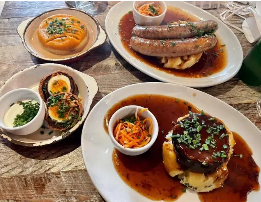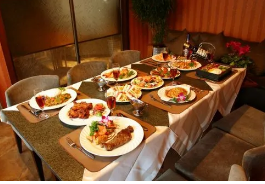What do British families like to eat for three meals a day, and the average age of 86
8 min read
As reported by the Daily Mail late last year, the King’s Fund, an independent think tank, conducted a comprehensive study of life expectancy. The study found that male life expectancy reached 84.7 years, female life expectancy reached 87.6 years and average life expectancy reached 86.15 years. That is an increase of 4.5 years from the WHO’s last figure 10 years ago, and the fastest increase in Europe. Why do British people live so long? Here’s a look at what British families eat for three meals a day, with the average age expected to reach 86.
1. Breakfast Although the British diet is relatively simple compared to other European countries, the English breakfast is more varied than other European countries. Compared with European countries such as French and Italian food, British food has a smaller variety of dishes, ingredients and cooking methods, and it has a bad stereotype in the world. The British themselves often laugh at their own food culture, but in recent years, the impression of British food culture in foreign countries has changed.
The story of the English breakfast begins with the floating breakfast feasts of the gentry in the English country houses of the 13th century. Recipes, recipes, and specific dishes strictly follow Anglo-Saxon traditions. It is a vanity fair where wealth, land, blood, and cooking skills are displayed. Breakfast, the most important meal of the day, was a very important social activity in the gentry’s way of life. Add to this the ancient Anglo-Saxon tradition of hospitality – the habit of entertaining family, friends, neighbours and passing tourists with a hearty breakfast.
After Queen Victoria came to the throne, the gentry had declined and a new rich class of merchants and factory owners had risen. They need a way to show their wealth and taste. After learning from the experience of those who came before us, breakfast once again shows its profound significance. The Victorians took breakfast from an ancient tradition to an art form — sparing no effort and effort to prepare more traditional and exotic ingredients in traditional ways.
The English breakfast, despite its name, doesn’t have to be eaten in the morning. As Maugham said, you can eat it for three meals a day. A full English breakfast usually includes bacon, eggs, English sausage, baked beans in tomato sauce, roasted mushrooms, black pudding and bread, tea or coffee. But remember, this is just a general menu, and there are more than 30 other foods that could be added to this list.
British families have a variety of breakfast bread choices, can be the most common sliced bread, whole wheat bread, also can be rye bread, yeast bread, English crumpet, English muffin and so on. The most common breakfast dish is English bacon, which is usually the outer ridged bacon. It’s mostly lean, with a little bit of rib/belly fat around the edges. Fry it in a little oil and you have the bacon of an English breakfast. In fact, almost all the ingredients in an English breakfast are fried, so they are often called fry-ups.
Sausage and eggs are also necessary for breakfast, egg practice is more, there are fried eggs, western scrambled eggs, eggs and so on. The sausages in the English breakfast, usually pork sausages, appear most frequently in the two varieties named after their country of origin – Cumberland sausages and Lincolnshire sausages. The most common breakfast is tea and coffee. The most common tea choices are English breakfast tea and Earl Grey tea, both of which are blends.
Baked beans in tomato sauce is also a must-have for breakfast in most British families, and its function is to neutralize the fat with acidity. It’s rather cumbersome to make your own, so you usually use canned beans. The classic is Heinz Blue. Breakfast vegetables usually include roasted tomatoes and mushrooms, either whole baby tomatoes or sliced in half, fried with a little olive oil and seasoned with salt and pepper.
The British also love to eat cheese for breakfast. The British are probably nomadic people at heart. Besides producing good meat, cheese is also a national pride. Cheddar is the most consumed cheese in the world today, and Stilton is one of the top three blue cheeses in the world. Other famous cheeses such as Cheshire and Caerphilly are also famous around the world. You may not find milk stalls in English markets, but you will find cheese stalls, all of which are of good quality.
2. Lunch The early British food culture was mainly influenced by topographic and climatic factors. Its geographical location was in the Atlantic Ocean on the west side of Europe, and its latitude was in the north of 50 degrees. Due to the regulation of the North Atlantic current and the blowing of the west wind all the year round, the temperate Marine climate was formed, which was warm in winter and cool in summer and humid all the year round. As the largest island nation in Europe, Britain is also blessed with unique resources. This climate fostered the growth of succulent grasses, so the English grew mainly forage crops and developed animal husbandry and dairy farming. In such a natural environment, Britain’s meat and seafood food resources can be described as the world’s top.
Later, British food culture was influenced by Rome and France, but this exquisite and complicated Roman food culture was only accepted by a small part of the relatively wealthy upper class of Britain. Crops from the Romans did not survive in Britain’s changeable climate, but much culinary knowledge was lost when the Romans left. In 1066, William, Duke of Normandy of France, succeeded to the British throne. The arrival of the Normans brought the splendid French and Italian food culture, which injected new vitality into the British food culture.
In the 18th century, Britain took the lead in the Industrial Revolution and its national strength rose rapidly. In the trend of industrialization, people also change their dietary needs from the pursuit of taste to filling their stomachs. In working families, the daily diet evolved into simple boiling, with lunch consisting of a piece of boiled meat and two boiled vegetables, one of which was a potato. Takeaways were also born out of the demands of the Industrial revolution, with cheap, shelf-stable food such as fish and chips giving workers quick and efficient fuel to fill their bellies. They, like the Industrial Revolution, changed the way people lived in Britain. Fish and chips is still a feature of the British diet.
When it comes to fish and chips, British Marine fish is mentioned. The most common way in British families is to fry, roast and steam the original flavor. At most, butter is added to flavor, lemon juice is added to remove the fishiness, and some simple herbs are added, everything is simple. This concept is similar to the Japanese, Cantonese and other coastal peoples’ understanding of Marine fish: for high-quality fresh seafood, only the most simple cooking, without any extra conditioning to give full play to its original flavor, is the best conditioning.
British conditioning fish may also add some appropriate conditioning, for crustacean food is completely uphold the original flavor. Oysters, cockles and other shellfish are all raw, shrimp, crab, lobster, mussels, razor clams and so on are only blanched in water to be cooked immediately out of the food, in addition to lemon juice and no seasoning. Cooking top quality oysters is considered to be exposing nature; Mussels are now made with French flavors such as parsley, garlic, white wine juice and saffron, but the traditional British recipe is steamed mussels with the most original flavor.
Lunch is inseparable from the British potato, its dependence on and love of potatoes can be seen, fried potato, baked potato, mashed potato, potato cake, potato soup, potato cake, potato scones, almost human can imagine potato dishes can be found in Britain. In the UK, cheese and chips are very popular national lunch food, the fusion of the two, rich taste, rich milk flavor. Fry until the fries are golden brown. Put them in a box and drizzle with yogurt salad dressing, spicy honey sauce, a dash of pomegranate and a final dash of chopped parsley for garnish.
The sumo burger, which originated in Birmingham, is one of the fast foods that working Brits love for lunch. It is both beautiful and delicious. Sumo burgers have even taken burger making to the next level. The beef is cooked with fresh Onions, pickled gherkins, sesame oil, tomato sauce, bean sprouts and fresh watercress, and is sandwiched between crispy burger embryos. When eating, multiple flavors burst out in the mouth.
Sandwiches and rolls are also the first choice for lunch food, especially fried chicken rolls have been deeply loved by the British people, rich and colorful vegetables, with special barbecue sauce, instant fried chicken pieces, using the traditional Japanese fried method, the chicken bites into the juices, this roll, rich taste, low price, very popular with the British people.
3. (Evening) (meal) The English family will also love potatoes for dinner, this habit is formed through history. In the late 18th century, innovations in the textile industry ushered in the Industrial Revolution, but also led to a rapid rise in unemployment. At the same time, severe weather in 1794-95 caused widespread famine, and the government rushed out a series of guidelines detailing “how to grow and eat potatoes” to fill the wheat gap — after all, one acre of potatoes could feed almost as many people as three acres of wheat. To this day, potatoes are a staple food in Britain rather than a vegetable.
In the early 19th century, when the Industrial Revolution was in full swing, farmers abandoned their land and flocked to the new industrial cities to become workers. Eliza Acton, a chef at the time, noted that the traditional art of stews seemed to have disappeared altogether: “The healthy, delicious and cheap home-cooked stew, widely popular in France and other countries, has been completely neglected in England”.
How can workers study cooking when they live in cramped apartments and grab a sandwich on the way home? Moreover, canned meat imported from America was half as cheap as its weight of fresh meat. Canned fruits and vegetables, packaged soup packets, margarine, condensed milk, and bread mixes invaded the kitchen so much that housewives gave up complicated family recipes and relied on product instructions to create a decent dinner.
The average life expectancy in the UK was less than 60 years, mind you, and it wasn’t until after World War II that the government began to educate the public that vegetables should be cooked simply or eaten raw so as not to destroy valuable vitamins and other healthy eating campaigns that people began to pay attention to healthy eating. As Britain’s strength slowly recovered, British people’s dietary requirements gradually increased.
Nowadays, in addition to seafood, British families also like to eat meat for dinner. Compared with the relatively simple cooking methods of seafood, British people seem to leave their imagination to meat. The best way to taste meat is always to roast it, and a fragrant, well-done, succulent roast is an enduring British expectation for dinner. At the same time, the British have their own rules for barbecue seasoning: beef with horseradish sour cream, mutton with mint sauce, pork with applesauce, and so on. In addition, there are fried steaming, bacon bacon brined meat braised meat, clear soup thick soup, endless stew and so on countless conditioning methods.






